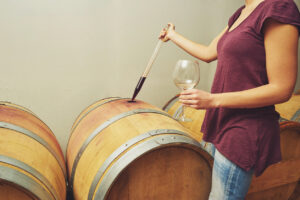Plenty of first batches taste thin or a little off. That’s almost always down to the kit or how it’s used. What makes the difference isn’t expensive gear or years of training. It’s having the right winemaker kit and understanding which details truly matter during each step. Whether you’re a first-time hobbyist or someone looking to upgrade your results, the path to better homemade wine starts here.
What Is a Winemaker Kit and Why Should You Use One?
A winemaker kit provides the essentials for turning grape juice or concentrate into wine. But not all kits are created equal. Basic sets may include fermentation vessels and airlocks, while more comprehensive options provide hydrometers, siphons, sanitiser, and corkers. A good kit helps you maintain cleanliness to avoid contamination, monitor fermentation progress accurately, and control temperature and oxygen exposure. These factors directly influence how the wine tastes. Fermentation done right gives you wine that’s clearer, smoother, and holds up over time.
What Do You Get in a Good Winemaker Kit?
A quality kit should contain all the essential components to take you from raw ingredients to bottled wine: a primary fermenter (usually a bucket with lid), a secondary fermenter such as a glass demijohn or stainless steel tank, siphoning equipment like a racking cane and tubing, an airlock and rubber bung to manage airflow, a hydrometer for tracking fermentation progress, sanitising solution to keep your equipment sterile, and basic instructions or a recipe sheet. Some kits also include corkers and bottle fillers to support the final stage of winemaking.
Why Choose Polsinelli Winemaking Equipment?
At CM Watermelons, we’ve partnered with Polsinelli, Italy’s premier winemaking equipment manufacturer, because their craftsmanship delivers the consistency and quality that home winemakers need. From grape crushers and ratchet wine presses to stainless steel fermenters, bottling machines, and crown cappers, every tool they design reflects over 60 years of family-driven expertise. Whether you’re just getting started or levelling up your setup, Polsinelli equipment offers performance you can count on.
View our Polsinelli winemaking equipment range here.
A quality kit should contain a primary fermenter (usually a bucket with lid), a secondary fermenter like a glass demijohn or carboy, siphoning equipment such as a racking cane and tubing, an airlock and rubber bung, a hydrometer to track fermentation progress, sanitising solution, wine yeast and nutrient, and a basic instruction sheet. These tools work together to help you manage the process cleanly and efficiently from start to finish.
How Important Are Ingredients When Making Wine at Home?
Even the best winemaker kit can’t save poor ingredients. Starting with good grape juice, fresh concentrate, or a reliable fruit source makes all the difference. If you’re using concentrate, choose one designed specifically for wine production. Supermarket juice blends may ferment, but they rarely deliver the texture or balance you’re aiming for.
Which Type of Winemaker Kit Is Right for You?
Not all winemaker kits serve the same purpose. Choosing the right one depends on your level of experience, your wine style preference, and your available space. Beginner kits are perfect for newcomers and typically come with simplified instructions and essential tools. Advanced kits suit experienced hobbyists who want to fine-tune every stage of production. Fruit wine kits are designed for those making wine from berries, apples, or other fruits. Compact kits are ideal for small kitchens and often use smaller fermentation vessels. Knowing your goals helps you select a winemaker kit that matches your needs.
How Does Fermentation Work in Home Winemaking?
This is where timing, temperature, and yeast selection come into play. Your kit should come with a guide or instructions, but real success depends on selecting the right yeast strain for your grape or fruit type, keeping fermentation between 18–24°C for most red wines and slightly cooler for whites, and allowing enough time for both primary and secondary fermentation to complete. Rushing this step can result in strange flavours or fermentation that just stalls out.
What Happens After Fermentation in Winemaking?
After fermentation, you’ll need to rack the wine (transfer it off sediment), stabilise it, and let it mature. This is where patience becomes your biggest asset. A good winemaker kit will include tools like a racking cane and fining agents to help clarify and stabilise your wine. Avoid the temptation to bottle too soon wine benefits from several weeks or even months of rest before it hits the glass.
What Are the Most Common Mistakes to Avoid with a Winemaker Kit?
Even with the right tools, certain mistakes can lead to disappointing results. Skipping sanitisation is one of the biggest errors any leftover bacteria can spoil an entire batch. Bottling too early may result in cloudy wine or unwanted carbonation. Using untreated tap water, which often contains chlorine, can affect flavour. It’s better to use filtered or boiled and cooled water. Finally, storing wine in a warm or unstable environment increases the chance of spoilage. Even with solid gear, the outcome depends on how closely you follow each step.
How Do You Bottle Wine Properly at Home?
Sterilise everything. Use proper corks. Avoid oxygen exposure. A decent kit makes this easier with bottle fillers, mini corking machines, and heat-shrink capsule sealers that help you maintain control and reduce the risk of spoilage. Polsinelli’s Enolmatic filling machines are especially helpful for semi-automated bottling at home, while their tabletop corkers and heat shrinkers give your bottles a professional finish. If you’ve done everything else right, don’t let the final step undo your hard work.
What’s the Real Secret Behind Great Homemade Wine?
A winemaker kit is only as good as the attention you give to each step. But with the right tools and a little know-how, your next batch can be clear, balanced, and genuinely enjoyable to drink. And once you’ve nailed the basics, there’s a whole world of customisation to explore from oak chips to secondary fermentations and blending trials.
I still remember my first successful batch after upgrading to a proper kit. The clarity, aroma, and structure were miles ahead of what I’d made before. Upgrading my gear didn’t just simplify things. It completely changed the result.
Frequently Asked Questions About Winemaker Kits
How long does it take to make wine with a winemaker kit?
About 4–6 weeks from start to bottle, depending on the recipe and temperature control.
How much wine can I produce from one kit?
Most standard kits yield about 30 bottles (22.5 litres) of finished wine.
Can I reuse my equipment for future batches?
Yes, if it’s thoroughly cleaned and sanitised after each use.
Is homemade wine shelf-stable?
Yes, if it’s properly stabilised and stored in cool, dark conditions.
Not sure what you need to get started? Contact us today and we’ll guide you through your options no pressure, just helpful advice from a team with 40+ years in the field.
Looking for guidance that fits your space, skill level, and wine goals?
We’ll help you find the right tools and techniques to match. Whether you’re starting from scratch or levelling up, we’re happy to walk you through it.



